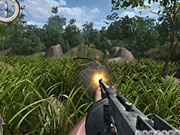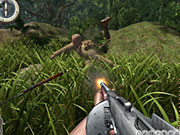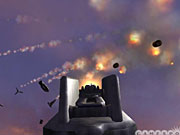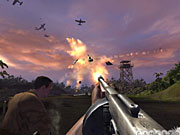Medal of Honor: Pacific Assault Preview
The next PC game in the Medal of Honor series will take place in the Pacific Rim.
EA's Medal of Honor series has made a name for itself by featuring exciting, fast-paced, realistic World War II action, as well as providing accessible, easy-to-learn gameplay. Though the franchise has given rise to numerous excellent games--that take place in various European theaters of war--the development teams decided some time ago to head east to cover the Allied assault on the Pacific Rim. Pacific Assault chronicles the career of a single soldier and his buddies on a campaign that takes them to Guadalcanal, Papua, and Makin Atoll, and eventually to the climactic and bloody battle for the tiny island of Tarawa in 1943.

With the new game, the team at EALA wanted to accomplish several tasks, like including realistic squad tactics for US and Japanese soldiers and implementing realistic physics to make Medal of Honor look better than ever before. To this end, the team decided to develop a brand-new game engine from the ground up, along with a little extra help from Havok physics. At this point in time, the game engine has all its features in place, and the team is now looking to build levels and other content into the game. Yet, even now, what is in place looks extremely impressive.
Pacific Assault features huge, complex outdoor environments. Of course, they have to be, considering that much of the territory in the war effort consisted of jungles and islands all surrounded by water and dense foliage. The game's complex physics engine features realistic water effects that cause water not only to look shiny and reflective but also to behave realistically. Shooting at the surface of water kicks up spray and a network of ripples; a flock of waterfowl flying past will also ripple the surface. Many bodies of water actually have currents that drags objects (and players) when caught in them.
These advanced physics also extend to physical objects. There's realistic high grass that sways in the wind, parts when characters walk through it, and waves about as the result of grenade explosion shockwaves. The physics also allow for wooden bridges to be blown to pieces by grenades--causing planks of wood to plunge into the water only to bounce back and bob along the surface. The engine actually accounts for weight. The game also uses Havok physics to simulate rag-doll animations for downed soldiers who tumble to the ground when shot, or hurtle through the air if caught in the blast radius of a grenade or land mine.

Pacific Assault uses fairly complex special effects that have been compiled by designers with expertise in both games and motion pictures. The team uses modern-day 3D software to render complicated explosions that consist of many smaller effects (flames, gouts of smoke, and clouds of dust on the ground). These are then added to the game engine, and each explosion is presented in real time. In some of the later levels, you see explosions and gunfire all over the place. However, we were assured that the game is still playable on midrange computers with decent graphics cards. Pacific Assault also gives your sound card a workout. The Medal of Honor series has always made a name for itself with its fantastic and highly realistic sound effects. The new game continues this tradition and has been developed with even more in-depth sound recordings. These recordings were not only completed on location in various parts of Japan and the Pacific islands, but they were also carried out by using multiple real-world weapons on closed shooting ranges.
These new changes are intended to help progress Medal of Honor beyond its previous reliance on scripted events--the exciting, action-packed scripted events that were always identical when you played. Instead, a lot of what goes on in Medal of Honor is "procedural." That is, gameplay happens in real time, as determined by the engine and not by any sort of premade sequence. This even holds true for the game's impressive squad AI.
The House of the Rising Sun
Pacific Assault features complex AI that realistically models the squad behavior of both US marines and Japanese infantry. Marines will aggressively advance on their enemies by providing covering fire or tossing a grenade and ducking behind cover. In the game, you're actually part of a squad and must follow a sergeant who gives you hand signals that indicate when you must move silently, lie prone, advance, or prepare for an ambush by going turtleback against cover. Similarly, Japanese soldiers use the same tactics they did in the war. Squad leaders march at the front of their ranks. If these squad leaders are defeated, severe morale penalties are inflicted on the remaining Japanese troops. Demoralized Japanese soldiers may abandon caution and "banzai" (charge headlong at enemies with extended bayonets).

Not all of Pacific Assault's soldiers are cannon fodder; some are actually with you from the beginning of the game until the end. However, if you're careless, some of your buddies may become severely wounded and drop out of action. This renders them inaccessible until the next level. Soldiers change dramatically in appearance and mannerisms over the course of the game due to EALA's highly complex character models; these models realistically present a character's skin tone, mouth (including polygonal teeth, lip-synced lips, and a fully modeled tongue), and eyes (with inset irises). War wounds are even realistic, and cuts may develop scars during the course of the game. Nearby explosions can cause soldiers to develop nasty bruises that swell eyes shut over the course of several minutes of game time. Characters even grow leaner over time. We saw a baby-faced character who was first presented as a good-natured private with a double chin. He gradually developed into a thin-faced, surly sergeant first class. Yet, as EALA's designers explained, these incredibly subtle details aren't intended to be a big deal, in and of themselves; instead, the team simply hopes to make characters who seem genuinely human--not artificial or lacking in the mannerisms and movements you'd expect of them.
Interestingly, your actions affect your teammates and your subsequent missions over the course of the game. In one mission, you may be tasked with defending a series of Allied ammo caches, and, if you allow one or more of them to be destroyed, you and your squad may have less ammo in the next mission. Your teammates will definitely chide you for it. At other points, you may have the opportunity to save a teammate from harm. Succeed, and he'll thank you for it later. Fail, and he may complain to you in a later mission (he may also sustain a wound that later becomes a scar). If you and/or your teammates are injured severely enough, you can call for your squad's medic. If you've got a man down, you have the option of performing an even riskier maneuver. You can pick up the wounded man and carry him to the medic. However, you have to be careful when doing so, since Japanese soldiers will specifically target medics in Pacific Assault, just as they did in the war.

Even Pacific Assault's vehicles display complex AI. A demonstration level was presented to us that showed a sky filled with 100 Japanese and US planes. They were simply spawned in and allowed to dogfight. The behaviors and skills of pilots vary from mission to mission because of the differences in US and Japanese training methods during the war. The top US pilots would be used as trainers, while the top Japanese pilots would immediately sally forth into battle. The Americans benefited from a constant supply of trained pilots, while the Japanese eventually lost their best pilots over the course of the war. Planes have a rudimentary damage model that lets you destroy them more quickly if you target their engine blocks. They not only go up in spectacular midair explosions, but they also rain huge chunks of debris on the ground, crushing any spectators who are too foolhardy to take cover.
Though it's still in the very early stages of development, Medal of Honor: Pacific Assault already looks extremely impressive. If the development team can make good on its intriguing ideas, it could be even more so. The game is scheduled for release next year, so stay tuned to GameSpot for future updates. In the meantime, watch our exclusive video interview with EALA senior producer Matt Powers.
Got a news tip or want to contact us directly? Email news@gamespot.com
Join the conversation